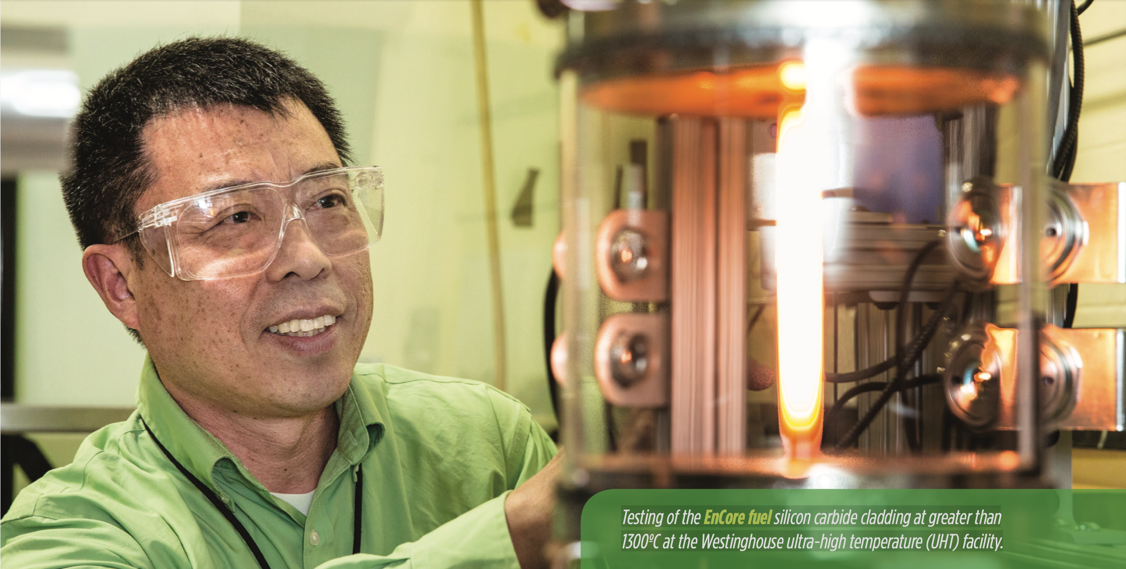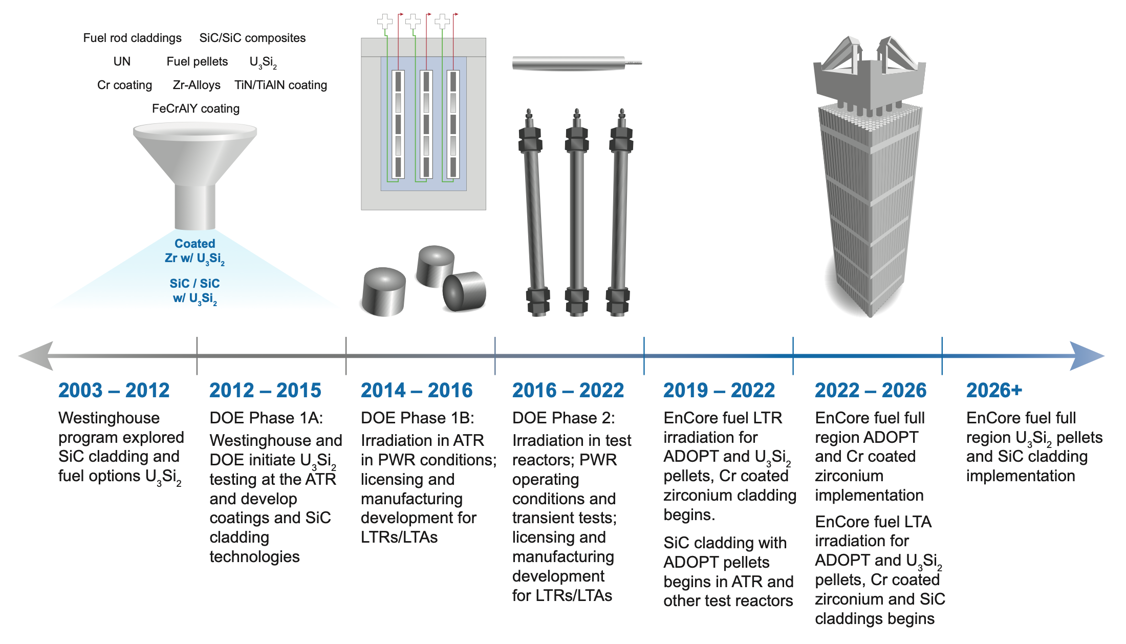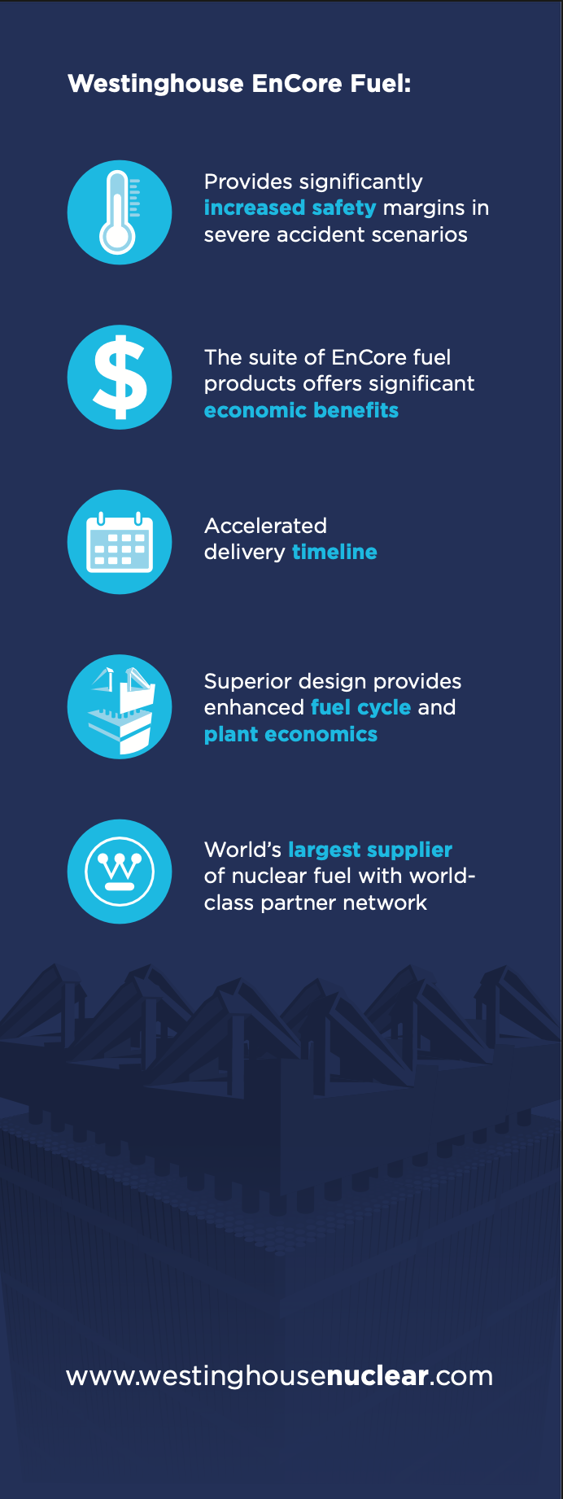
On Dec. 2, 1957, Westinghouse changed the world when Shippingport, the first commercial nuclear power station in the U.S., came online. Today, Westinghouse is changing nuclear energy again, building on our legacy of innovation with our revolutionary new accident-tolerant fuel (ATF) design, EnCore® fuel.
The EnCore fuel program will be delivered in two phases. The initial EnCore fuel product is comprised of coated cladding fuel rods loaded with ADOPTTM fuel pellets. The combination of this advanced rod coating along with Westinghouse’s proven ADOPT pellets can provide utilities with increased pellet uranium loading, improved fuel utilization, increased loss-of-coolant accident (LOCA) margins, enhanced debris fretting resistance and higher burnup.
The second phase of EnCore fuel program features silicon-carbide (SiC) cladding and advanced fuel
pellets. This is intended to offer significant safety benefits in beyond-design-basis accident scenarios, enabled by SiC’s extremely high melting point and the high thermal conductivity of the advanced fuels.
While current Westinghouse fuel designs have operated extremely well under normal plant conditions, existing nuclear fuel designs can be challenged when put under beyond-design-basis severe-accident scenarios. In the event of such conditions, the long-term loss of coolant and the resulting high temperatures of the fuel can lead to the degradation of the fuel cladding and the early release of fission products. EnCore fuel
is “game-changing” for the nuclear industry, significantly increasing safety margins in severe accident scenarios. Additionally, EnCore fuel offers flexibility for fuel management and provides a platform for utilities seeking higher rod burnup through higher enrichment.
Fuel Cladding
To achieve design-basis-altering safety, the introduction of EnCore fuel rods will utilize chromium-coated cladding. The reduced oxidation and hydrogen pickup achieved during normal operation (250°-350°C) is expected to prolong cladding life, provide enhanced resistance to wear and increase fuel operating margins. The coated cladding also supports extended exposure to high temperature steam and air (1300°-1400°C) during a loss-of-coolant accident (LOCA), reactivity- initiated accident (RIA) and beyond-design-basis conditions. Recent autoclave and irradiation tests for chromium-coated cladding have shown excellent corrosion resistance and irradiation stability, as well as improvements in mechanical performance at high temperature.
Development of SiC cladding is currently underway, intended to provide groundbreaking safety margin improvements. SiC cladding reacts 10,000 times slower with water and steam than zirconium at 1200°C, resulting in minimal generation of heat and hydrogen in beyond-design-basis accident scenarios.
Pellet Materials
Westinghouse’s chromia (Cr2O3) and alumina (Al2O3) doped UO2 pellet, known as our ADOPT pellet, will be enhanced for the first phase of the EnCore fuel program.
The improved ADOPT pellet design achieves greater uranium efficiency through:
Westinghouse has over 20 years of manufacturing experience with ADOPT pellets, delivering more than 2,700 fuel assemblies with ADOPT.
The second phase of our EnCore fuel program will introduce more advanced fuel pellet designs such as uranium silicide, uranium nitride or high thermal conductivity uranium dioxide pellets. These designs allow significantly more uranium to be packed into the same volume than current UO2. Uranium silicide’s increased thermal conductivity provides safety improvements by reducing the amount of stored energy while allowing a much higher linear heat rate, or burnup, before it melts.

Materials and modifications to existing fuel assembly design structures have been identified to support the EnCore fuel features. Zirconium- based structures appear to be feasible for both SiC and coated cladding. Further evaluation and confirmatory testing are being performed to demonstrate that adequate margins exist to support the increased uranium weight, changes in pressure drop and heat transfer rate of EnCore fuel. Lead test rods (LTRs) will utilize current fuel assembly designs with a combination of UO2, ADOPT pellets and U3Si2 rods to minimize structural impacts.
Efforts on codes and methods for EnCore fuel are being prioritized, with early focus on what will be needed for LTR and lead test assembly (LTA) design and licensing. Modifications will be made to incorporate properties and characteristics of the new claddings and fuel pellet materials, including empirical data from critical experiments to support full-region licensing.
Utilities seeking higher rod burnup (~75 GWd/ MTU) through higher enrichment (> 5w/o) can, with regulatory approval, utilize the benefits of EnCore fuel technologies to achieve this goal.
The reduced oxidation and hydrogen pickup of the coated cladding allows for use of higher density pellets, which helps to reduce fuel assembly loadings and achieve longer fuel cycles. The risk of ballooning and bursting of the cladding during a LOCA can be reduced via chromium-coated cladding, and likely eliminated altogether via SiC cladding. Both chromium-coated and SiC cladding will produce more margin to departure from nucleate boiling (DNB) and LOCA limits. There will also be more grid to rod fretting (GTRF) and debris resistance margin for higher duty operation. Innovative pellet designs can reduce fuel dispersal, reduce fission gas release, lower fuel temperatures and improve pellet clad mechanical interaction (PCMI) margin.

EnCore fuel’s economic and safety benefits come from fuel cycle impacts of replacing UO2 with ADOPT and/or U3Si2 pellets, and from positive impacts on plant core damage frequencies, primarily from incorporating coated zirconium and SiC composite cladding. Along with the increased safety margins inherent in accident-tolerant fuels, utility benefits will be realized as shown in the following table.
Other benefits include:

As the regulatory framework for accident tolerant fuel (ATF) technology evolves, Westinghouse continues to refine the licensing path for the EnCore fuel features. Westinghouse anticipates that general licensing of the EnCore fuel design will be achieved through U.S. Nuclear Regulatory Commission (NRC) review and approval of topical reports. Those topical reports should demonstrate compliance with applicable regulations and establish the key performance enhancements that EnCore fuel provides. Westinghouse expects that utilities will be able to reference these topical reports in their License Amendment Requests to adopt EnCore fuel.
Westinghouse conducts regular interactions with the NRC to provide information regarding the development, testing and licensing plans for EnCore fuel. Through these interactions, as well as engagement in NRC-sponsored public meetings, Westinghouse is helping to further develop regulatory structure and requirements for licensing ATF technologies. Westinghouse also continues to be an active participant in the Nuclear Energy Institute’s (NEI) efforts to achieve maximum benefits of ATF materials. Through these activities, Westinghouse works to ensure that the licensing path for the EnCore fuel designs maximizes the performance envelope while maintaining compliance with existing and near-term new regulatory requirements.
A key element of the licensing efforts is obtaining operational data from LTRs and LTAs. Westinghouse continues to build and strengthen additional partnerships to continue EnCore fuel LTR/LTA programs. As the NRC finalizes guidance to the industry on application of the 50.59 rule in the use of LTRs and LTAs, Westinghouse will assess application of this guidance for EnCore fuel programs.
Test fuel rods manufactured in 2018 and 2019 will undergo exposure in the Advanced Test Reactor (ATR) and Transient Reactor Test Facility (TREAT) reactors at Idaho National Laboratory, as well as several other test reactors to develop the data required for licensing. The test protocols will include pressurized water reactor (PWR) operating conditions and transient tests.
LTRs of coated cladding, ADOPT pellets and U3Si2 segments are currently being irradiated in Exelon Generation’s Byron Unit 2 since April of 2019. Additional LTR and/or LTA programs for coated cladding, ADOPT pellets, U3Si2 and SiC cladding are also being pursued.


The pursuit of accident-tolerant fuel is being carried out by an international, multidisciplinary team, funded in part by the U.S. Department of Energy’s direct awards to Westinghouse, General Atomics and several of the United States national laboratories. The team members and their primary missions on this project include: